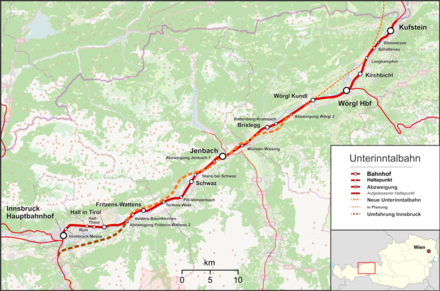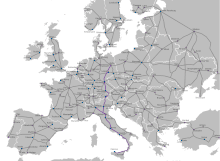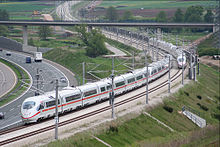Railway axis Berlin – Palermo
The Berlin – Palermo railway axis is the TEN priority project No. 1, the creation of a 2,200 km long railway - high-speed line between Berlin and Palermo has to content. Since 2014 this axis has been part of the TEN-T core network corridor Scandinavia-Mediterranean .
Route sections and expansion
The following cities are on the route:
|
|
|
|
|---|---|---|
| Berlin - Halle / Leipzig - Erfurt - Nuremberg - Ingolstadt - Munich - Rosenheim - | ( Kufstein - Wörgl -) Innsbruck - |
Franzensfeste - Bolzano - Verona - Bologna - Florence - Rome - Naples - Messina - Palermo |
Germany
The end point of this railway axis is Berlin Central Station in Germany . From there it leads across the 2,006 completed rail line Berlin-Halle / Leipzig . The new Leipzig / Halle-Erfurt line , which opened in December 2015, joins in Halle / Leipzig . Since December The connecting Erfurt-Nuremberg high-speed line will be available in 2017 . The high-speed line opened in 2006 via Ingolstadt is used from Nuremberg to Munich . The section of the Munich – Rosenheim railway line from Munich Central Station to Grafing near Munich has already been expanded to four tracks to separate long-distance traffic from the capacity-intensive Munich S-Bahn traffic. From Rosenheim the route will presumably run through a tunnel leading past Kufstein , which is still the subject of negotiations, to Austria. Currently (2016) [obsolete] the preparations for the route selection procedure for the new Rosenheim - Kufstein line and planning for the Rosenheim - Grafing section near Munich are in progress. (See also: Rosenheim – Kufstein border line )
Austria

In Austria, the axis includes the following routes:
- Lower Inn Valley Railway
- New Lower Inn Valley Railway and Brennern Nord inflow since 2012 partly in operation (Baumkirchen – Radfeld), partly in planning (Radfeld – Schaftenau – Rosenheim – Munich)
- Innsbruck bypass in operation since 1994
- Brennerbahn
- Brenner base tunnel under construction
The Austrian section is largely identical to the new Lower Inn Valley Railway. In addition, there is the Austrian share in the Brenner Base Tunnel, which is currently under construction . The Lower Inn Valley Railway will have the highest train volume on the entire TEN route because here (between Wörgl and Innsbruck) the international north-south traffic is superimposed on the inner-Austrian east-west traffic.
Its larger section, which is part of the TEN line, has already been completed and has been since December In operation in 2012 ( Kundl - Baumkirchen ). The shorter section Kufstein (possibly Brannenburg / Bavaria at the north portal of the above-mentioned tunnel south of Rosenheim) - Kundl, which also includes a bypass from Wörgl, is being planned. The Austrian section can take up to 220 km / h. In Baumkirchen the new high-speed line includes the one hand to the to the Brenner railway leading south Innsbruck umfahrenden Inntal tunnel , which is for freight already in operation on. On the other hand, it joins the existing line to Innsbruck Hbf . The Brenner Base Tunnel will later branch off in the Inn Valley Tunnel, which together with it will be the longest rail tunnel in the world (62.8 km). A second north branch leading into the base tunnel will be built from the southern edge of Innsbruck, which will be used for TEN long-distance trains stopping at Innsbruck main station, which on the other hand will use the existing route from and to Baumkirchen.
Italy

In the last few decades the following routes have been newly built or significantly expanded:
- Verona – Bologna railway line has been double-tracked since 2009 and with up to 200 km / h passable.
- Milan – Bologna high-speed line since 13. December In operation in 2008. (Branch of the TEN axis No. 1).
- High-speed route Bologna – Firenze (78 km) since 13. December In operation in 2009.
- Direttissima Firenze – Roma (254 km) in operation since 1991.
- High-speed line Roma – Napoli partly since 2005, completely since 13. December In operation in 2009.
- Napoli – Salerno high-speed line in operation since 2008.
The construction of a combined rail / road bridge crossing the Strait of Messina with a length of 3.3 km was planned, Italy's Prime Minister Mario Monti announced in October as part of budget cuts 2012 the final end of the project. On the mainland, proponents believe that the bridge would connect to the new section of the Salerno-Reggio Calabria motorway and the existing 400 km long railway connection Naples-Salerno-Reggio Calabria, the expansion of which will increase the speed and capacity of the line. On the island the 230 km long railway connection between Messina and Palermo largely expanded or newly laid.
From 888 km of routes between Turin and Naples run 143 km in tunnels. The routes are linked to the existing network at 15 locations. The estimated total costs (as of 2006) were 30 Billion euro.
EU coordinator
On 20. July In 2005 the European Union appointed EU coordinators for the five most important trans-European rail transport projects in order to accelerate the implementation of these projects. For the priority axis No. 1, the Belgian Karel van Miert was appointed as EU coordinator, but in June Died in 2009. The Irish Pat Cox was named as his successor .
Since 12. March In 2014, Pat Cox is European coordinator of the Scandinavian-Mediterranean Core Network Corridor from Helsinki and Oslo to Valletta.
See also
Web links
- Brenner north inlet - side of the ÖBB and DB for the cross-border expansion Kufstein - Rosenheim - Munich
- BEG (responsible for Austrian section)
- Action group Brennerbahn
- Bridge over the Strait of Messina (Italian / English)
Individual evidence
- ↑ http://www.brennernordzulauf.eu/protocol-zum-trassenwahlverfahren
- ↑ http://www.bvwp-projekte.de/schiene/2-009-V03/2-009-V03.html#h1_grunddaten
- ↑ Trans-European transport network TEN-T priority axes and projects 2005
- ↑ A high-speed network is being built in Italy . In: Eisenbahn-Revue International . Issue 8–9 / 2006, ISSN 1421-2811 , pp. 390-393.
- ↑ http://ec.europa.eu/transport/themes/infrastructure/ten-t-guidelines/european-coordinators/pat-cox_en.htm accessed on April 4, 2015

